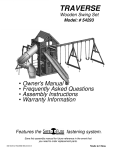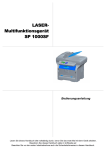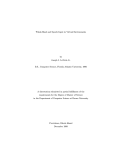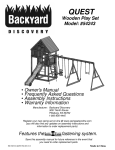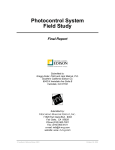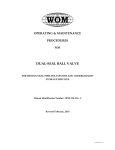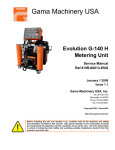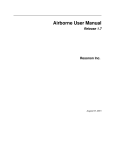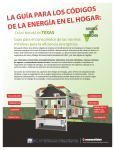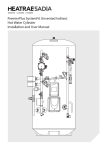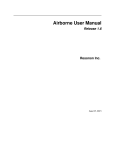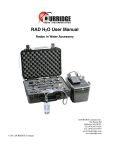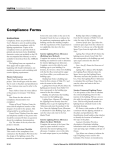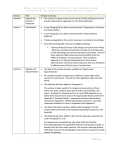Download ANSI/ASHRAE/IES Standard 90.1
Transcript
BUILDING ENERGY CODES UNIVERSITY ANSI/ASHRAE/IES Standard 90.1-2010 Envelope Edited & Presented by Donald Vigneau AIA Additional editing by Kevin Rose 1 April 2011 – PNNL-SA-80142 BUILDING ENERGY CODES UNIVERSITY www.energycodes.gov/BECU Compliance Approaches Building System Compliance Options Prescriptive Option Envelope Mandatory Provisions HVAC SWH (required for most compliance options) Power Trade Off Option Energy Code Compliance Energy Cost Budget Lighting Other Simplified 2 BUILDING ENERGY CODES UNIVERSITY www.energycodes.gov/BECU Buildings Today • Responsible for roughly 48% of our energy use and 70% of electricity consumption – The scope of energy codes cover about 67% of a building’s energy use • The average consumer spends $2,175 on energy bills every year 3 BUILDING ENERGY CODES UNIVERSITY www.energycodes.gov/BECU • 90.1-2010 savings vs. 90.1-2004 • ~25% with plug loads • ~31% without plug loads 4 BUILDING ENERGY CODES UNIVERSITY www.energycodes.gov/BECU Section 5 Building Envelope Overview General (Section 5.1) Scope Space-Conditioning Categories Envelope Alterations Climate Compliance Paths (Section 5.2) Simplified Building (Section 5.3) Not Used Mandatory Provisions (Section 5.4) Insulation Fenestration and Doors Air Leakage 5 BUILDING ENERGY CODES UNIVERSITY www.energycodes.gov/BECU 2012 Delaware Energy Codes Commercial Residential 90.1-2010 Section [RE] 1,2,4. Scope and Application / use [CE] C 103 for CDs 3. Definitions, Acronyms 4. Building Envelope 5-11 Commercial Energy Efficiency 12. Referenced Standards Ch. 1 Scope and Application / Administrative and Enforcement Ch. 2 Definitions Ch. 3 General Requirements Ch. 4 Residential Energy Efficiency Ch. 5 Referenced Standards 6 BUILDING ENERGY CODES UNIVERSITY 6 www.energycodes.gov/BECU Section 5 – 5.1.2 Building Envelope Scope Envelope components that enclose Conditioned space Semi-heated space – Has a heating system with a capacity > 3.4 Btu/h·ft2 of floor area but is not conditioned space – Approved by local official Requirements apply to three space conditioning categories Nonresidential Residential Semi-heated (no A/C) Figure 5-A Examples of Indirectly Conditioned Spaces (User’s Manual – 90.1.-2010) 7 BUILDING ENERGY CODES UNIVERSITY www.energycodes.gov/BECU COMcheck Option • This Option can be used to demonstrate compliance with 2012 IECC or ASHRAE Standard 90.1-2010 • User inputs all the building data • Will show if building can meet performance or tradeoff based compliance • When used, report shall be submitted with construction documents. New changes will use checklists from SCORE+STORE 8 BUILDING ENERGY CODES UNIVERSITY www.energycodes.gov/BECU Section 5 Building Envelope 9 BUILDING ENERGY CODES UNIVERSITY www.energycodes.gov/BECU Compliance Approach Building Envelope Building System Compliance Options Prescriptive Option Envelope Mandatory Provisions HVAC SWH (required for most compliance options) Power Trade Off Option Energy Code Compliance Energy Cost Budget Lighting Other Simplified 10 BUILDING ENERGY CODES UNIVERSITY www.energycodes.gov/BECU Section 5 – 5.4 Mandatory Provisions Fenestration and Doors (Section 5.8.2) Air Leakage (Section 5.4.3) Photo courtesy of Ken Baker, K energy 11 BUILDING ENERGY CODES UNIVERSITY www.energycodes.gov/BECU Section 5 – 5.4.3.1 Air Leakage – Continuous Air Barrier Continuous air barrier required except in semi-heated spaces • Plans – Air barrier components identified or noted in construction documents – Joints, intersections, and penetrations of air barrier components (incl. lighting fixtures) detailed • Extends over all surfaces of thermal envelope – From lowest floor, exterior walls, to ceiling or roof • Resists positive and negative pressures – Wind, stack effect, and mechanical ventilation 12 BUILDING ENERGY CODES UNIVERSITY www.energycodes.gov/BECU Section 5 – 5.4.3.1.2 Air Leakage – Air Barrier Installation Wrap, seal, caulk, gasket, or tape: • Joints around fenestration and door frames (both manufactured and site-built) • Junctions between walls – And foundations – At building corners – And roofs or ceilings • Penetrations for roofs, walls, and floors • Building assemblies used as ducts or plenums • Joints, seams, connections between planes, and other changes in air barrier materials 13 BUILDING ENERGY CODES UNIVERSITY www.energycodes.gov/BECU Section 5 – 5.4.3.1.3 Air Leakage Acceptable Air Barrier Materials and Assemblies Material Thickness (minimum) Plywood 3/8 in. Oriented strand board 3/8 in. Extruded polystyrene insulation board ½ in. Foil-faced urethane insulation board ½ in. Exterior gypsum sheathing or interior gypsum board ½ in. Cement board ½ in. Built up roofing membrane Modified bituminous roof membrane Fully adhered single-ply roof membrane A Portland cement / sand parge, stucco, or gypsum plaster ½ in. Cast-in-place and precast concrete sealed w/grout or paint Sheet metal Closed cell 2 lb/ft3 nominal density spray polyurethane foam 1 in. Materials air permeance tested in accordance with ASTM E 2178 using ≤ 0.004 cfm/ft2 at a pressure differential of 0.3 in. w.g.; Sealants/tapes tested in accordance with ASTM E 2357, 1677, 1680, or 283 BUILDING ENERGY CODES UNIVERSITY 14 www.energycodes.gov/BECU Moisture Diffusion in Materials MATERIAL PERM RATING VAPOR RETARDER(?) ½” GWB 38 -42 NO EPS, FIBERGLASS INSULATION ??-?? NO 52 NO 7.0 – 10.0 NO 7/16” OSB (*w/exterior glue) 0.77* – 3.48 SOMETIMES 1” XPS 0.40 – 1.60 SOMETIMES 7/16” Plywood (exterior glue) 0.70 YES Kraft Paper Facing 1.0 YES 2 mil polyethylene 0.06 – 0.22 YES Alkyd-base or V/R paint < 0.05 YES 1 mil aluminum foil laminate < 0.05 YES 0.05 – 0.80 YES TYVEK Latex Primer ½” GWB + VWC BUILDING ENERGY CODES UNIVERSITY 15 www.energycodes.gov/BECU Section 5 – 5.4.3.2 Air Leakage – Fenestration and Doors Product cfm/ft2 Glazed swinging entrance doors and revolving doors 1.0 AAMA/WDMA/CSA 101/I.S.2/A440, NFRC 400, or ASTM E283 1.57 Curtainwall and storefront glazing 0.06 NFRC 400 or ASTM E283 1.57 Unit skylights with condensation weepage openings 0.3 AAMA/WDMA/CSA 101/I.S.2/A440 or NFRC 400 1.57 Unit skylights with condensation weepage openings 0.5 AAMA/WDMA/CSA 101/I.S.2/A440 6.24 Non-swinging opaque doors 0.4 ANSI/DASMA 105, NFRC 400, or ASTM E283 1.57 All other products 0.2 AAMA/WDMA/CSA 101/I.S.2/A440 or NFRC 400 1.57 All other products 0.3 AAMA/WDMA/CSA 101/I.S/A440 6.24 Procedure psf Exceptions – Field-fabricated fenestration and doors – Metal coiling doors in semi-heated spaces in Climate Zones 1-6 16 BUILDING ENERGY CODES UNIVERSITY www.energycodes.gov/BECU Section 5 – 5.4.3.3 Air Leakage Loading Dock Weatherseals Cargo doors and loading dock doors equipped with weather seals – To restrict infiltration when vehicles are parked in the loading dock/doorway – What about dock levelers? 17 BUILDING ENERGY CODES UNIVERSITY www.energycodes.gov/BECU Section 5 – 5.4.3.4 Air Leakage – Vestibules Required in Climate Zones 4 for entrances in buildings > 1000 ft2 Vestibules must have Self-closing doors Interior and exterior doors not open at the same time Distance between interior and exterior doors not < 7 ft when in closed position (remember ADA!) 18 BUILDING ENERGY CODES UNIVERSITY www.energycodes.gov/BECU Section 5 Air Leakage Vestibule Exceptions Non-entrance doors Building entrances with revolving doors All entrances in buildings < 1000 ft2 in Climate Zone 4 All doors that open from spaces < 3000 ft2 (separate from building entrance) Doors from dwelling units 19 BUILDING ENERGY CODES UNIVERSITY www.energycodes.gov/BECU Compliance Approach Building Envelope Building System Compliance Options Prescriptive Option Envelope HVAC SWH Mandatory Provisions (required for most compliance options) Power Trade Off Option Energy Code Compliance Energy Cost Budget Lighting Other Simplified 20 BUILDING ENERGY CODES UNIVERSITY www.energycodes.gov/BECU Section 5 – 5.5 Prescriptive Building Envelope Option Rules Window/Wall Ratio ≤ 40% of gross wall area (IECC 30%) Skylight-roof Ratio ≤ 5% of roof area Each envelope component must separately meet requirements Criteria sets for 8 different climate types Z4 = single page that summarizes all prescriptive requirements – Insulation levels for roofs, walls, floors – Fenestration criteria 21 BUILDING ENERGY CODES UNIVERSITY www.energycodes.gov/BECU Envelope: Zone 4 Insulation Only changes are for nonresidential metal buildings New requirements: ASHRAE Standard 90.1 Version Metal Roof R-Value Metal Above-Grade Wall R-Value Above-Grade Wood Frame Wall R-Value 90.1-2007 19 13 13 90.1-2010 13+13 19 13 22 BUILDING ENERGY CODES UNIVERSITY www.energycodes.gov/BECU Section 5 – 5.8.1 Insulation Installation Per manufacturer’s instructions Achieve rated R-value No open-blown or poured loosefill insulation when ceiling slope is > 3/12 If eave vents installed – Provide baffling of air vents to deflect incoming air above the surface of the insulation Exception: Metal buildings • if roof and wall insulation is compressed between roof or wall skin and the structure 23 BUILDING ENERGY CODES UNIVERSITY www.energycodes.gov/BECU Section 5 High Albedo Roof – (not required in Zone 4A) 24 BUILDING ENERGY CODES UNIVERSITY www.energycodes.gov/BECU Section 5 Above-Grade Wall Insulation Four types of walls are defined Mass walls – heat capacity: Table A3.1B or A3.1C – R-value is for continuous insulation Metal building wall R-value – insulation compressed between metal wall panels and the steel structure Steel-framed wall R-value – uncompressed insulation installed in the cavity between steel studs Wood-framed and other R-value – uncompressed insulation installed in the wood stud cavities; also continuous insulation uninterrupted by studs 25 BUILDING ENERGY CODES UNIVERSITY www.energycodes.gov/BECU Section 5 - 5.5.3.3 Below-Grade Wall Insulation Meet or exceed values in appropriate table for climate zone R-value is for continuous insulation Exception If framing is used, compliance is based on maximum assembly C-factor Photo courtesy of Dow Building Solutions 26 BUILDING ENERGY CODES UNIVERSITY www.energycodes.gov/BECU Section 5 – 5.5.3.5 Slab-on-Grade Floor Insulation Meet or exceed values in appropriate table for climate zone (includes R-value and depth or width of insulation) Be installed around the perimeter to the distance specified Inside foundation wall – extend downward from top of slab a minimum distance specified or to the top of the footing, whichever is less Outside foundation wall – extend from top of the slab or downward to at least the bottom of the slab and then horizontally to a minimum distance specified 27 BUILDING ENERGY CODES UNIVERSITY www.energycodes.gov/BECU Section 5 – 5.5.4 Fenestration Criteria apply to fenestration, including windows, glass doors, glass block, plastic panels, skylights and rooftop monitors Compliance maximum U-factors in table ≥minimum SHGC in table Use NFRC ratings or default values in Appendix A 28 BUILDING ENERGY CODES UNIVERSITY www.energycodes.gov/BECU Section 5 – 5.5-1 (cont’d) Opaque TABLE 5.5-1 (Cont’d) 29 BUILDING ENERGY CODES UNIVERSITY www.energycodes.gov/BECU Section 5 – 5.5.4.2.3 Skylight Fenestration Area Skylights are required in enclosed spaces that are: • ≥ 5,000 ft2 area and • > 15 ft Ceiling height and • One of these space types – – – – – – – Office - Convention Center - Transportation Lobby - Automotive Service - Workshop Atrium - Manufacturing Concourse - Non-refrigerated Warehouse Corridor - Retail Storage - Distribution/Sorting Area Gymnasium/Exercise Center 30 BUILDING ENERGY CODES UNIVERSITY www.energycodes.gov/BECU Section 5 Solar Heat Gain Coefficient (SHGC) The glazing’s effectiveness in rejecting solar heat gain • NFRC 200 Standard • Replaces shading coefficient (SC) in product literature and design standards Exceptions SC x 0.86 is acceptable for overall fenestration area (NFRC 300) SHGC of center-of-glass is acceptable (NFRC 300) for overall fenestration area SHGC from A8.1 for glazed wall systems vertical fenestration and skylights SHGC from A8.2 for other vertical fenestration in 31 BUILDING ENERGY CODES UNIVERSITY www.energycodes.gov/BECU Information – 5.5.4.4.1 Overhangs 90.1 credits permanent overhangs by adjustment to SHGC Size of overhang is determined by projection factor 32 BUILDING ENERGY CODES UNIVERSITY www.energycodes.gov/BECU Section 5 – 5.5.4.4.2 Skylight SHGC Skylights SHGC values < Table value for appropriate total skylight area Exceptions, if skylights: • Have a glazing material or diffuser with measured haze value > 90% when tested according to ASTM D1003 • Have a skylight VT > 0.40, and • Have all general lighting in daylight area under skylights controlled by multilevel photo-controls per Section 9.4.1.5 Dynamic Glazing • Minimum SHGC is used to demonstrate compliance • Considered separately from other vertical fenestration • Area-weighted averaging with other vertical fenestration that isn’t dynamic glazing isn’t allowed 33 BUILDING ENERGY CODES UNIVERSITY www.energycodes.gov/BECU Section 5 – 5.5.4.5 Fenestration Orientation Vertical fenestration area to meet this requirement: Area South ≥ Area West and Area South ≥ Area East North Nope! Yup! Exceptions: • Buildings shaded by other buildings within 20 ft to the south which is at least ½ as tall as the proposed building • Buildings with shade on 75% of the west and east • Alterations and additions that don’t increase vertical fenestration area 34 BUILDING ENERGY CODES UNIVERSITY www.energycodes.gov/BECU Section 5 Visible Transmittance Determined in accordance with ASTM E972 A measure of the amount of visible light that passes through fenestration Affected by composition of the glass coatings internal shading devices Relationship between VT and SHGC Daylighting without excessive solar gain– VT at least 1.2 x SHGC Exception For skylights not within scope of NFRC 200, VT to be the solar photometric transmittance of the skylight glazing material in accordance with ASTM E972 35 BUILDING ENERGY CODES UNIVERSITY www.energycodes.gov/BECU Compliance Approaches Building System Compliance Options Prescriptive Option Envelope HVAC SWH Mandatory Provisions (required for most compliance options) Power Trade Off Option Energy Code Compliance Energy Cost Budget Lighting Other Simplified 36 BUILDING ENERGY CODES UNIVERSITY www.energycodes.gov/BECU Section 5 – 5.6 Building Envelope Trade-Off Option Building complies if It satisfies the provisions of 5.1, 5.4, 5.7, and 5.8 Envelope performance factor (EPF) of proposed building is ≤ EPF of budget building – EPF considers only the building envelope components and is calculated using procedures in Normative Appendix C – Schedules of operation, lighting power, equipment power, occupant density, and mechanical systems to be the same for both the proposed building and the budget building 37 BUILDING ENERGY CODES UNIVERSITY www.energycodes.gov/BECU Section 5 – 5.8.1.5 Insulation - Substantial Contact Install insulation in a permanent manner in substantial contact with inside surface Flexible batt insulation in floor cavities Supported in a permanent manner by supports no more than 24 in. on center (o.c.) 38 BUILDING ENERGY CODES UNIVERSITY www.energycodes.gov/BECU Section 5 – 5.8.1.6 Recessed Equipment Do not recess equipment that affects insulation thickness Lighting fixtures HVAC equipment (wall heaters, ducts, plenums) Other Except when Total combined area affected (include necessary clearances) is < 1% of opaque area of the assembly, OR Entire roof, wall, or floor is covered with insulation to the full depth required, OR Effects of reduced insulation are included in area-weighted calculations 39 BUILDING ENERGY CODES UNIVERSITY www.energycodes.gov/BECU Section 5 – 5.8.1.7 Insulation Protection Insulation Protection Cover exterior insulation with protective material – – – – – Sunlight Moisture Landscaping operations Equipment maintenance Wind Access to attics and mechanical rooms without damaging or compressing insulation Insulation materials in ground contact to have a water absorption rate ≤ 0.3% (ASTM C272) Example 40 BUILDING ENERGY CODES UNIVERSITY www.energycodes.gov/BECU Section 5 – 5.8.1.8 Suspended Ceilings Roof Insulation Not installed on a suspended ceiling with removable ceiling panels Non-compliant 41 BUILDING ENERGY CODES UNIVERSITY www.energycodes.gov/BECU Standard 90.1-2010 Appendices and Addenda A. Rated R-Value of Insulation and Assembly U-Factor, C-Factor, and F-Factor Determinations B. Building Envelope Climate Criteria C. Methodology for Building Envelope Trade-Off Option in Subsection 5.6 D. Climatic Data E. Informative References F. Addenda Description Information (Informative) G. Performance Rating Method (Informative) 42 BUILDING ENERGY CODES UNIVERSITY www.energycodes.gov/BECU BUILDING ENERGY CODES UNIVERSITY ANSI/ASHRAE/IES Standard 90.1-2010 HVAC Edited & Presented by Donald Vigneau AIA 1 April 2011 – PNNL-SA-80143 BUILDING ENERGY CODES UNIVERSITY www.energycodes.gov/BECU HVAC Compliance Building System Compliance Options Prescriptive Option Envelope HVAC SWH Mandatory Provisions (required for most compliance options) Power Trade Off Option Energy Code Compliance Energy Cost Budget Lighting Simplified Other 2 BUILDING ENERGY CODES UNIVERSITY www.energycodes.gov/BECU 5.1.2 and DEFINITIONS - Space • • • • • Each space to be categorized as: Nonresidential conditioned space, or Residential conditioned space Unconditioned space Spaces are assumed to be conditioned spaces at time of construction regardless of presence of HVAC in the building permit application, or not installed. • Spaces in climate zone 4 may be designated as semi-heated or unconditioned only when approved as such by the building official. • Semi-heated space: > 3.4 and < 15 Btu/h 3 BUILDING ENERGY CODES UNIVERSITY www.energycodes.gov/BECU Section 6 – 6.1.1 HVAC Scope New Buildings and Additions All HVAC requirements apply to new equipment & systems Existing equipment may remain in use, with some modifications Alterations Compliance in Existing Buildings Equipment – Replacement equipment: meet new minimum efficiencies Cooling systems – New systems serving previously uncooled spaces – Alterations to existing systems shall not decrease economizer capacity (unless tradeoff exception can be used) Ductwork – New and replacement ductwork : meet requirements for new Piping – New and replacement piping: meet requirements for new 4 BUILDING ENERGY CODES UNIVERSITY www.energycodes.gov/BECU HVAC: Equipment Efficiencies Significant Efficiency Rating Increases: • Packaged Heat Pumps/Air Conditioners • Air-cooled and water-cooled chillers – Changes for part-load chillers • Air-cooled Air Conditioners and Heat Pumps • Water-cooled Air Conditioners and Heat Pumps • 6.5.9 Hot gas bypass limits • Table 6.8.1 IPLV/IEER ratings 5 BUILDING ENERGY CODES UNIVERSITY www.energycodes.gov/BECU Section 6 – 6.1.1.3 HVAC Alterations Alterations to existing building HVAC systems Exceptions allowed: – Equipment being modified or repaired (not replaced) • provided such modifications will not result in an increase in the annual energy consumption – Equipment being replaced or altered which requires extensive revisions to other systems, equipment, or building elements, and such replaced or altered equipment is a like-for-like replacement – Refrigerant change for existing equipment – Relocation of existing equipment – Ducts and pipes where insufficient space or access exists to meet these requirements 6 BUILDING ENERGY CODES UNIVERSITY www.energycodes.gov/BECU Section 6 – 6.2 HVAC Compliance Paths Must follow Sections – 6.1 General, – 6.7 Submittals, – 6.8 Minimum Equipment Efficiency Then choose either – 6.3 Simplified Approach (must meet limitations) OR – 6.4 Mandatory Provisions and either – 6.5 Prescriptive Path OR – Ch.11 Energy Cost Budget (ECB) Method 7 BUILDING ENERGY CODES UNIVERSITY www.energycodes.gov/BECU Section 6 – 6.3 Simplified Approach Option The simplified approach is an optional path for compliance when the following are met: Buildings < 3 stories Gross floor area < 25,000 ft2 Single zone HVAC system Unitary packaged or split air conditioners (air-cooled or evaporatively cooled) 17 Criteria (2 new) Mandatory provisions do not apply 85% of all buildings 8 BUILDING ENERGY CODES UNIVERSITY www.energycodes.gov/BECU Section 6 – 6.3 Simplified Approach Option (cont’d) Balancing of ducted systems Outdoor air intake and exhaust systems Interlocked thermostats for separate heating and cooling System > 10,000 cfm: – optimum start controls Demand control ventilation 9 BUILDING ENERGY CODES UNIVERSITY www.energycodes.gov/BECU HVAC: Economizers and ERVs • Economizers are now required for all systems with cooling capacities over 33,000 Btu/h (6.3.2/6.5.1) • Economizer exception: tradeoffs increase from 9 to 11 (6.5.1) • Energy Recovery (ERV) systems (6.5.6) now required for all systems with greater than 30% outside air – Sizing based on new Table 6.5.6.1/6.3.2 – One new Exception (j) 10 BUILDING ENERGY CODES UNIVERSITY www.energycodes.gov/BECU Economizer Exceptions – Table 6.3.2 Addendum “cy” introduces an updated Table 6.3.2. The Table exempts the requirement for economizers through the use of higher efficiency HVAC equipment. Table 6.3.2 is based on the new benchmark building models, and was expanded to allow use for any type of HVAC system, not just for unitary air-cooled equipment in the current table. 11 BUILDING ENERGY CODES UNIVERSITY www.energycodes.gov/BECU Section 6 – 6.3 Simplified Approach Option (cont’d) Manual changeover or dual set-point thermostat Heat pump supplementary control No reheat or simultaneous heating and cooling for humidity control Time clocks (except hotel/motel guest rooms and systems requiring continuous operation) 12 BUILDING ENERGY CODES UNIVERSITY www.energycodes.gov/BECU Section 6 – 6.3 Simplified Approach Option (cont’d) Piping and ductwork/plenum insulated Reference Tables 6.8.2A and B on page 68 in 90.1-2010 13 BUILDING ENERGY CODES UNIVERSITY www.energycodes.gov/BECU Pipe Sizing and Insulation • Maximum allowable flow rates for chilled and condensed water – Based on nominal pipe size • New requirements for pipe insulation for heating systems – Increases 0.5”-2” depending on tube size and temp range – Four Exceptions to Tables 14 BUILDING ENERGY CODES UNIVERSITY www.energycodes.gov/BECU Section 6 – 6.4.4.1.3 (6.3.2k) Piping Insulation Tables 6.8.3A and 6.8.3B Exceptions Factory-installed Piping conveying fluids – design operating temperature range between 60 F-105 F, inclusive – that haven’t been heated or cooled through the use of fossil fuels or electricity or where heat gain or heat loss will not increase energy usage Hot water piping between shut off valve and coil, not > 4 ft in length, when located in conditioned spaces Piping ≤ 1 in. – No insulation required for strainers, control values, and balancing values 15 BUILDING ENERGY CODES UNIVERSITY www.energycodes.gov/BECU Section 6 – 6.5.6.1 (6.3.2f) Exhaust Air Energy Recovery Required if: Supply air capacity ≥ value listed in Table 6.5.6.1 – Values are based on climate zone and 70% of outdoor air flow rate at design conditions Recovery system effectiveness ≥ 50% Ten Exceptions: one new Performance testing: new requirement 16 BUILDING ENERGY CODES UNIVERSITY www.energycodes.gov/BECU Section 6 – 6.8.2B (6.3.2l) Duct & Plenum Insulation Climate Zone 4 • Exterior R-6 • Vented Attic R-6 • Unvented Attic R-6 • Conditioned Attic R-3.5 • Unconditioned Space R-3.5 • Indirect conditioned Space N/R Reference Table 6.8.2B on page 68 in 90.1-2010 17 BUILDING ENERGY CODES UNIVERSITY www.energycodes.gov/BECU Section 6 – 6.4.3.9 (6.3.2q) Demand Control Ventilation (DCV) DCV must be provided for each zone with a area > 500 ft² and the design occupancy > 40 people/1000 ft² where the HVAC system has: An air-side economizer, Automatic modulating control of the OSA dampers, or A design outdoor airflow > 3,000 cfm Demand control ventilation (DCV): a ventilation system capability that provides for the automatic reduction of outdoor air intake below design rates when the actual occupancy of spaces served by the system is less than design occupancy. 18 BUILDING ENERGY CODES UNIVERSITY www.energycodes.gov/BECU HVAC Compliance Building System Compliance Options Prescriptive Option Envelope HVAC SWH Mandatory Provisions (required for most compliance options) Power Trade Off Option Energy Code Compliance Energy Cost Budget Lighting Simplified Other 19 BUILDING ENERGY CODES UNIVERSITY www.energycodes.gov/BECU Section 6 – 6.4 HVAC Mandatory Provisions Minimum Equipment Efficiency (Section 6.4.1) Calculations (Section 6.4.2) Controls (Section 6.4.3) HVAC System Construction and Insulation (Section 6.4.4) 20 BUILDING ENERGY CODES UNIVERSITY www.energycodes.gov/BECU Section 6 – 6.4.1.1 Minimum Equipment Efficiency HVAC Equipment Covered in Tables 6.8.1 (A) to (K) Air conditioners and condensing units Heat pumps (air, water, and ground source) Water-chilling packages (chillers) Packaged terminal and room air conditioners and heat pumps Furnaces, duct furnaces and unit heaters Boilers Heat rejection equipment (cooling towers) Heat transfer equipment (heat exchangers) Variable refrigerant flow (VRF) air conditioners VRF air-to-air and applied heat pumps Air conditioners serving computer rooms 21 BUILDING ENERGY CODES UNIVERSITY www.energycodes.gov/BECU Section 6 – 6.4.2.1 Load Calculations Must calculate heating and cooling system design loads Must determine calculations with ANSI/ASHRAE/ACCA Standard 183-2007 22 BUILDING ENERGY CODES UNIVERSITY www.energycodes.gov/BECU Section 6 – 6.4.3.1 Controls – Zone Thermostatic & Dead Band Required for each zone Perimeter can be treated differently Dead band controls Thermostats must have at least a 5 F dead band Exceptions – Thermostats that require manual changeover between heating and cooling modes – Special occupancy or applications where wide temperature ranges aren’t acceptable (e.g., retirement homes) and approved by adopting authority 23 BUILDING ENERGY CODES UNIVERSITY www.energycodes.gov/BECU Section 6 – 6.4.3.3 Controls – Off-Hour Temperature Control off-hour requirements Automatic shutdown Setback controls Optimum start Zone isolation Exceptions, HVAC systems – with heating/cooling capacity < 15,000 Btu/h – intended to operate continuously 24 BUILDING ENERGY CODES UNIVERSITY www.energycodes.gov/BECU Section 6 – 6.4.3.3.3 Controls - Optimum Start Individual heating and cooling air distribution systems with Total design supply air capacity > 10,000 cfm Served by one or more supply fans Control algorithm to at least be a function of Difference between space temperature and occupied setpoint and amount of time prior to scheduled occupancy 25 BUILDING ENERGY CODES UNIVERSITY www.energycodes.gov/BECU Section 6 – 6.4.3.3.4 Controls - Zone Isolation Applies to Each floor in a multistory building Maximum 25,000 ft2 zone on one floor Requirements Isolation devices to shut off outdoor and exhaust airflow when > 5,000 cfm Central systems shall be capable of stable operation with one isolation zone Capable of separate time schedules for each isolation zone Figure 6-E Isolation Methods for a Central VAV System (User’s Manual – 90.1.-2007) 26 BUILDING ENERGY CODES UNIVERSITY www.energycodes.gov/BECU Section 6 – 6.4.3.4.4 Ventilation Fan Controls Fans with motors > 0.75 hp shall have automatic controls complying with Section 6.4.3.3.1 that are capable of shutting off fans when not required Exception HVAC systems intended to operate continuously 27 BUILDING ENERGY CODES UNIVERSITY www.energycodes.gov/BECU Section 6 – 6.4.3.4.5 Enclosed Parking Garage Ventilation Ventilation systems in enclosed parking garages automatically detect contaminant levels and stage fans or modulate fan airflow rates to ≤ 50%, provided acceptable contaminant levels are maintained Exception Garages < 30,000 ft2 with ventilation systems that use mechanical cooling or heating Garages with a garage area to ventilation system motor nameplate hp ratio > 1500 ft2/hp and don’t use mechanical cooling or heating Where permitted by AHJ 28 BUILDING ENERGY CODES UNIVERSITY www.energycodes.gov/BECU Section 6 – 6.4.4.1.2 Duct and Plenum Insulation Insulate all supply & return ducts & plenums per Tables 6.8.2A and 6.8.2B Exceptions HVAC factory-installed plenums, casings, or ductwork in equipment Ducts located in heated, semi-heated, or cooled spaces R-value 3.5 for runouts < 10 ft long to air terminals or air outlets Insulation for backs of air outlets and outlet plenums exposed to unconditioned or indirectly conditioned spaces: R-2 with face areas > 5 ft2 No insulation with face areas ≤ 5 ft2 29 BUILDING ENERGY CODES UNIVERSITY www.energycodes.gov/BECU • Duct Sealing (cq) • Ductwork and plenums with pressure ratings shall be seal class A • Shaft openings require bushings • 25% of duct systems over 3” w.c. and ALL outdoor ducts shall be leak tested • Tested sections chosen by owner • Leakage class = 4 for all ducts 30 BUILDING ENERGY CODES UNIVERSITY www.energycodes.gov/BECU Section 6 – 6.4.4.2.2 Duct Leakage Tests Designed > 3 in. w.c. Leak tested Representative sections ≥ 25% of the total installed duct area shall be tested Ratings > 3 in. w.c. to be identified on drawings Maximum permitted duct leakage 31 BUILDING ENERGY CODES UNIVERSITY www.energycodes.gov/BECU HVAC Compliance - Prescriptive Building System Compliance Options Prescriptive Option Envelope HVAC SWH Mandatory Provisions (required for most compliance options) Power Trade Off Option Energy Code Compliance Energy Cost Budget Lighting Simplified Other 32 BUILDING ENERGY CODES UNIVERSITY www.energycodes.gov/BECU Section 6 – 6.5 HVAC Prescriptive Path Economizers (6.5.1Two new exceptions) Simultaneous Heating and Cooling Limitation (6.5.2 – several exception additions/clarifications) Air System Design and Control (6.5.3 New Ventilation Optimization and supply air controls) Hydronic System Design and Control (6.5.4 DDC controls) Heat Rejection Equipment (6.5.5.3 Cooling tower limits) Energy Recovery (6.5.6 New Exception ‘j’ ) Exhaust Systems (6.5.7 New kitchen & lab requirements) Radiant Heating Systems (Section 6.5.8) Hot Gas Bypass Limitation (Section 6.5.9) 33 BUILDING ENERGY CODES UNIVERSITY www.energycodes.gov/BECU Section 6 – 6.5.1.3 Economizers (cy) • 2007 None required Zone 4A • (65,000Btu/h IECC) • 2010 54,000Btu/h • None required for computer rooms • Requires water economizer for some zones to be humidified • Run cooling towers in the winter • Hospitals & some labs – Economizers must be integrated with mechanical cooling systems and be capable of providing partial cooling even when additional mechanical cooling is required 34 BUILDING ENERGY CODES UNIVERSITY www.energycodes.gov/BECU Section 6 – 6.5.2.2 Hydronic System Controls To prevent the simultaneous heating and cooling in hydronic systems 35 BUILDING ENERGY CODES UNIVERSITY www.energycodes.gov/BECU Section 6 – 6.5.2.2.1 Three-Pipe System A common return hydronic system for both hot and chilled water is still prohibited 36 BUILDING ENERGY CODES UNIVERSITY www.energycodes.gov/BECU Section 6 – Table 6.5.3.1A Fan Power Limitation Two options: • nameplate hp (Option 1) • fan system brake hp (Option 2) • Table 6.5.3.1.1B sets forth adjustments Exceptions Hospital, vivarium and laboratory systems utilizing flow control devices on exhaust and/or return to maintain space pressure relationships necessary for occupant health and safety or environmental control may use variable-volume fan power limitation Individual exhaust fans with motor nameplate hp ≤ 1 hp Fans exhausting air from fume hoods (new) 37 BUILDING ENERGY CODES UNIVERSITY www.energycodes.gov/BECU Section 6 – 6.5.3.3 Multi-zone VAV Optimization Control (New) In multiple-zone VAV systems with DDC of individual zone boxes reporting to central control panel Include means to automatically reduce outdoor air intake flow below design rates in response to changes in system ventilation efficiency as per Standard 62.1, Appendix A Exceptions VAV systems with zonal transfer fans that recirculate air from other zones without directly mixing it with outdoor air, dual-duct dual-fan VAV systems, and VAV systems with fan-powered terminal units Systems required to have exhaust air energy recovery complying with 6.5.6.1 Systems where total design exhaust airflow is > 70% of total outdoor air intake flow requirements 38 BUILDING ENERGY CODES UNIVERSITY www.energycodes.gov/BECU Section 6 – 6.5.3.4 Supply-air Temperature Reset Controls (NEW) (NEW) Multiple zone HVAC systems to have controls to automatically reset supply-air temperature in response to building loads or outdoor air temperature Controls to be capable of resetting supply air temperature at least 25% of difference between design supply-air temperature and design room air temperature. Controls that adjust the reset based on zone humidity are okay Zones expected to experience relatively constant loads to be designed for fully reset supply temperature Exceptions Systems that prevent reheating, recooling or mixing of heated and cooled supply air 75% of energy for reheating is from site-recovered or site solar energy sources 39 BUILDING ENERGY CODES UNIVERSITY www.energycodes.gov/BECU Section 6 – 6.5.4 Hydronic System Design and Control HVAC hydronic systems with total pump system power > 10 hp to meet 6.5.4.1 – 6.5.4.4 Hydronic Variable Flow Systems – pumps > 5hp (50hp - 2007) Pump Isolation Chilled and Hot Water Temperature Reset Hydronic (water-loop) Heat Pumps and Water-Cooled Unitary Air-Conditioners – Exception for water economizers Pipe Sizing - added 40 BUILDING ENERGY CODES UNIVERSITY www.energycodes.gov/BECU Section 6 – 6.5.7 Exhaust Systems Kitchen exhaust (expanded requirements) Field testing requirement (new) Laboratory exhausts Reduced airflow limit to 5,000 cfm (from 15,000 cfm) Three air volume reduction options 41 BUILDING ENERGY CODES UNIVERSITY www.energycodes.gov/BECU Service Water Heating (SWH) Building System Compliance Options Prescriptive Option Envelope HVAC SWH Mandatory Provisions (required for most compliance options) Power Trade Off Option Energy Code Compliance Energy Cost Budget Lighting Simplified Other 42 BUILDING ENERGY CODES UNIVERSITY www.energycodes.gov/BECU BUILDING ENERGY CODES UNIVERSITY ANSI/ASHRAE/IES Standard 90.1-2010 Power and Lighting 1 April 2011 – PNNL-SA-79907 BUILDING ENERGY CODES UNIVERSITY www.energycodes.gov/BECU Compliance Power Building System Compliance Options Prescriptive Option Envelope HVAC SWH Mandatory Provisions (required for most compliance options) Power Trade Off Option Energy Code Compliance Energy Cost Budget Lighting Other Simplified 2 BUILDING ENERGY CODES UNIVERSITY www.energycodes.gov/BECU Section 8 – Power - SCOPE Low-Voltage Dry Type Distribution Transformers New Buildings Additions Alterations Mandatory Provisions Voltage drop Automatic receptacle control Submittals: Drawings & Manuals 3 BUILDING ENERGY CODES UNIVERSITY www.energycodes.gov/BECU Section 8 – 8.4.1 Voltage Drop Two types of conductors Feeder conductors – Connect service equipment to the branch circuit breaker panels – 2% maximum voltage drop allowed at design load Branch circuit conductors – Run from the final circuit breaker to the outlet or load – 3% maximum voltage drop allowed at design load These are more stringent than non-enforceable requirements in the National Electric Code (NEC) Exception Feeder conductors and branch circuits dedicated to emergency services 4 BUILDING ENERGY CODES UNIVERSITY www.energycodes.gov/BECU Section 8 – 8.4.2 Automatic Receptacle Control ≥ 50% of all 125 volt 15- and 20-amp receptacles (including those in modular partitions) must be controlled by an automatic control device in these space types Private offices Open offices Computer classrooms Exceptions Receptacles designated for equipment requiring 24 hr operation Spaces with security or safety concerns 5 BUILDING ENERGY CODES UNIVERSITY www.energycodes.gov/BECU Power - Receptacles (bs) • Exceptions: • Receptacles specifically designated for equipment requiring 24 hour operation • Spaces where patient care is rendered • Spaces where an automatic shutoff would endanger the safety or security of the room or building occupant(s). 6 BUILDING ENERGY CODES UNIVERSITY www.energycodes.gov/BECU Section 8 – 8.7 Power Submittals Owner gets information about the building’s electrical system Record drawings of actual installation within 30 days – Single-line diagram of electrical distribution system – Floor plans showing location and areas served for all distribution Manuals – Submittal data stating equipment rating – O&M manuals for equipment – Qualified service agency – Complete narrative of system as it’s normally intended to operate 7 BUILDING ENERGY CODES UNIVERSITY www.energycodes.gov/BECU Compliance Lighting Building System Compliance Options Prescriptive Option Envelope HVAC SWH Mandatory Provisions (required for most compliance options) Power Trade Off Option Energy Code Compliance Energy Cost Budget Lighting Simplified 8 BUILDING ENERGY CODES UNIVERSITY www.energycodes.gov/BECU Basic Lighting Requirements Mandatory Requirements (Interior and Exterior) Interior Lighting Power Limits + + Exterior Lighting Power Limits Tradable Total Connected Power Controls < Interior Lighting Power Allowance Exemptions NonTradable Switching Exemptions Efficiency Building Area Space-by-Space Total Connected Power < Exterior Lighting Power Allowance Additional Allowances 9 BUILDING ENERGY CODES UNIVERSITY www.energycodes.gov/BECU Section 9 Lighting General Application (Section 9.1) • • • • Scope Lighting Alterations Installed Interior Lighting Power Luminaire Wattage Compliance Path(s) (Section 9.2) Mandatory Provisions (Section 9.4) • • • • Lighting control Exit signs Exterior building lighting power Functional testing Building Area Method Compliance Path (Section 9.5) Space-by-Space Method Alternative Compliance Path: (Section 9.6) Submittals (Section 9.7) 10 BUILDING ENERGY CODES UNIVERSITY www.energycodes.gov/BECU Section 9 Lighting General Scope Interior spaces of buildings Exterior building features Exterior grounds lighting powered through building Exceptions – Emergency lighting – Lighting required by life safety statute – Lighting within dwelling units of buildings – Decorative gas lighting 11 BUILDING ENERGY CODES UNIVERSITY www.energycodes.gov/BECU Lighting: Retrofits / Oversight • Any project/retrofit which alters 10% of the connected lighting load must comply with 90.12010. • All lighting controls must be tested and documented by a 3rd party that the equipment has been installed to manufacturer’s specifications and meet performance criteria. Applies to these retrofits: • Where luminaires are added, replaced, or removed • Includes lamp plus ballast 12 BUILDING ENERGY CODES UNIVERSITY www.energycodes.gov/BECU Section 9 Interior Lighting Power Lots of exemptions (2 new categories) Calculation methods Building area Space-by-space Trade-offs of interior lighting power allowance aren’t allowed when both allowed methods are used in different portions of the building 13 BUILDING ENERGY CODES UNIVERSITY www.energycodes.gov/BECU Section 9 - Table 9.5.1 Building Types Part of Table 9.5.1 Building Type Lighting Power Density (W/ft2) Automotive Facility 0.90 0.82 Convention Center 1.20 1.08 Court House 1.20 1.05 Dining: Bar Lounge/Leisure 1.30 0.99 Dining: Cafeteria/Fast Food 1.40 0.90 Dining: Family 1.60 0.89 Dormitory 1.00 0.61 Exercise Center 1.00 0.88 14 BUILDING ENERGY CODES UNIVERSITY www.energycodes.gov/BECU Lighting: Light Power Density • Across-the-board reductions in Light Power Density (LPD) in watts/sf. • Introduction of Room Cavity Ratio (RCR) Adjustment, allows 20% increase in LPD for unusually tall or wide spaces. 15 BUILDING ENERGY CODES UNIVERSITY www.energycodes.gov/BECU • Addendum “by” changes: • • For most building types, the LPDs are reduced. • Table shows samples. • Average LPDs: • • 90.1-2007……… avg.=1.09 • • 90.1-2010……... Avg.=0.906 • • Difference …….. -16.9% 16 BUILDING ENERGY CODES UNIVERSITY www.energycodes.gov/BECU Section 9 Gross Lighted Area Sum of total lighted area of a building Measured from the exterior faces of the exterior walls or from the centerline of walls separating buildings, but excluding a long list of uses. (See Standard). Used in the building area method of determining interior lighting power allowance 17 BUILDING ENERGY CODES UNIVERSITY www.energycodes.gov/BECU 9.6.3 - Added LPD Adjustment Room Cavity Ratio Adjustment for relief in unusual spaces • Use only when applying the space by space method • Calculate the Room Cavity Ratio (RCR) for the empty room: RCR = 2.5 x Room Cavity Height x room perimeter length room area (Room Cavity Height = Luminaire mounting height – Workplane) • If RCR is greater than the RCR threshold for that space type, a 20% increase is allowed • For corridor/transition spaces, this adjustment is allowed when less than 8 feet wide, regardless of the RCR 18 BUILDING ENERGY CODES UNIVERSITY www.energycodes.gov/BECU Added LPD Adjustment 19 BUILDING ENERGY CODES UNIVERSITY www.energycodes.gov/BECU Added LPD Adjustment 20 BUILDING ENERGY CODES UNIVERSITY www.energycodes.gov/BECU 9.6.2 Merchandise Lighting • Addendum “bq” reduces the allowance for specific lighting to highlight merchandise • This shows proposed reductions for the additional interior Lighting Power Allowance (LPA): • • • • • Example: LPA = 1000 watts general space lighting + (Retail area 1 x 1.0 0.6 W/ft2 – all other except 2, 3, 4 below) + (Retail area 2 x 1.7 0.6 W/ft2 – vehicles, sporting goods …) + (Retail area 3 x 2.6 1.4 W/ft2 – furniture, clothing, artwork…)) + (Retail area 4 x 4.2 2.5 W/ft2 – jewelry, crystal, china) 21 BUILDING ENERGY CODES UNIVERSITY www.energycodes.gov/BECU Section 9 – 9.6.2 Advanced Controls Incentive If all mandatory control requirements are met for a space AND advanced controls are installed in that space, THEN additional limited lighting power is allowed: Additional power can be used anywhere in the building Additional Interior Lighting Power Allowance is calculated as Lighting Power Under Control x Control Factor Partial Table 9.6.2 Control Factors Used in Calculating Additional Interior Lighting Power Allowance 22 BUILDING ENERGY CODES UNIVERSITY www.energycodes.gov/BECU Lighting: Controls • Automatic shutoff controls required in nearly all spaces. • All lighting controls must be “manual-on” or “automatic-on” to only 50% power. • Multi-level automatic daylighting controls required when – primary sidelighted area exceeds 250sf – primary toplighted area exceeds 900sf • Requirements for “auto-off” plug load receptacles 23 BUILDING ENERGY CODES UNIVERSITY www.energycodes.gov/BECU OCCUPANCY SENSORS • Occupancy Sensors • Added training rooms, lecture halls, storage 50-1000sf • Manual on • Exceptions – restrooms, public corridors and stairs • Bi-level control for most spaces • Not corridors • Parking Garage • Reduce power 30% if no activity in >3,600sf area 24 BUILDING ENERGY CODES UNIVERSITY www.energycodes.gov/BECU Section 9 – 9.4.1.2 Mandatory Individual Space Control Additional space control required for Display/accent lighting Case lighting Task lighting Nonvisual lighting Demonstration lighting Stairwell lighting 25 BUILDING ENERGY CODES UNIVERSITY www.energycodes.gov/BECU Section 9 – 9.4.1.2 Mandatory Additional Space Controls Guestroom lighting must be controlled at room entry • Suites must be controlled at entry to each room or primary entry • Bathrooms controlled to automatically turn off lighting within 60 minutes of occupant leaving space – Exception: night lighting not > 5W 26 BUILDING ENERGY CODES UNIVERSITY www.energycodes.gov/BECU Section 9 – 9.4.1.2 Mandatory Additional Space Controls Stairwells • Automatic reduction control for lighting in enclosed stairwells to – Automatically reduce lighting power in any control zone by at least 50% within 30 minutes of all occupants leaving the zone 27 BUILDING ENERGY CODES UNIVERSITY www.energycodes.gov/BECU Section 9 – 9.4.1.3 Parking Garage Lighting Control THERE ARE CONTROL EXCEPTIONS BUILDING ENERGY CODES UNIVERSITY 28 www.energycodes.gov/BECU Section 9 – 9.4.1.3 Parking Garage Lighting Control 29 BUILDING ENERGY CODES UNIVERSITY www.energycodes.gov/BECU • Lighting Controls - daylighting • Rules first added 2010 • Addenda: d, ab, al, ct • Opaque obstacles >5’ tall cut off areas 30 BUILDING ENERGY CODES UNIVERSITY www.energycodes.gov/BECU Daylit Lighting Controls (ab) Controls required for daylighted spaces • • • • Primary sidelighted area Secondary sidelighted area Toplighting Daylighted area (under skylights) 31 BUILDING ENERGY CODES UNIVERSITY www.energycodes.gov/BECU Section 9 – 9.4.1.4 Daylight Zone Definition – Under Skylights © 2010, ASHRAE, ANSI/ASHRAE/IES Standard 90.1-2010, Figure 3.1 BUILDING ENERGY CODES UNIVERSITY 32 www.energycodes.gov/BECU Section 9 – 9.4.1.4 Daylight Zone Definition – Under Rooftop Monitors © 2010, ASHRAE, ANSI/ASHRAE/IES Standard 90.1-2010, Figure 3.2 BUILDING ENERGY CODES UNIVERSITY 33 www.energycodes.gov/BECU Section 9 – 9.4.1.4 Automatic Daylighting Controls for Primary Sidelighted Area © 2010, ASHRAE, ANSI/ASHRAE/IES Standard 90.1-2010, Figure 3.3 BUILDING ENERGY CODES UNIVERSITY 34 www.energycodes.gov/BECU Section 9.4.5 Exterior Lighting Power Exterior Building Lighting Power (ELP) must meet prescribed wattage limits. Exterior applications divided into 2 categories: • Tradable: allowed wattage may be traded among these applications • Non-Tradable: allowed wattage cannot be traded between surfaces or with other exterior lighting Three new ELP exemptions 35 BUILDING ENERGY CODES UNIVERSITY www.energycodes.gov/BECU Section 9.4.5 Exterior Lighting Power Zones 36 BUILDING ENERGY CODES UNIVERSITY www.energycodes.gov/BECU Lighting: Exterior • Exterior lighting now uses a Zone System to set LPD allowances. • New exterior lighting controls: – Lighting must be off during daytime – Lighting must be turned off 12 AM – 6 AM, or building opening – closing – Advertising must be reduced by at least 30% after hours or when area is unoccupied 37 BUILDING ENERGY CODES UNIVERSITY www.energycodes.gov/BECU Exterior Control (cd) and Incentives • MUST turn off exterior lighting when sufficient daylight is available • Use astronomical timer or daylight sensor • Façade and landscape lighting off from midnight or closing to 6am or opening • Addendum AC allows more LPD if more controls are added • Most options allow 5-10% increase 38 BUILDING ENERGY CODES UNIVERSITY www.energycodes.gov/BECU Section 9.4.4 Functional Testing (az) • Functional testing (calibrated/adjusted/programmed) of lighting control devices and systems required within 90 days of occupancy – Must be performed by individuals NOT involved in design, manufacture, or installation – For occupant sensors, time switches, programmable controls, or photosensors, verify: • • • • All performance criteria met Occupant sensor time-out and sensitivity settings Timers and programs set to turn lights off Photosensor controls effectively control lighting in response to daylight 39 BUILDING ENERGY CODES UNIVERSITY www.energycodes.gov/BECU Section 9 – 9.7 Submittals Record drawings for each piece of lighting equipment: Location Luminaire identifier Control Circuiting Operation and maintenance manuals 40 BUILDING ENERGY CODES UNIVERSITY www.energycodes.gov/BECU Credits Content and images in this presentation provided by resources from: Building Codes Assistance Project DOE Building Energy Codes Program National Renewable Energy Laboratory energycodesocean.org energycodes.gov nrel.gov/data/pix 41 BUILDING ENERGY CODES UNIVERSITY www.energycodes.gov/BECU This concludes this American Institute of Architects Continuing Education Systems Program Company Name/Logo BUILDING ENERGY CODES UNIVERSITY [email protected] [email protected] 781-860-9177 Ext.136 781-860-9177 Ext.158 42 www.energycodes.gov/BECU































































































































